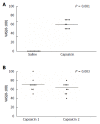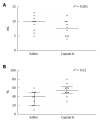Influence of capsaicin infusion on secondary peristalsis in patients with gastroesophageal reflux disease
- PMID: 28018112
- PMCID: PMC5143751
- DOI: 10.3748/wjg.v22.i45.10045
Influence of capsaicin infusion on secondary peristalsis in patients with gastroesophageal reflux disease
Abstract
Aim: To determine whether capsaicin infusion could influence heartburn perception and secondary peristalsis in patients with gastroesophageal reflux disease (GERD).
Methods: Secondary peristalsis was performed with slow and rapid mid-esophageal injections of air in 10 patients with GERD. In a first protocol, saline and capsaicin-containing red pepper sauce infusions were randomly performed, whereas 2 consecutive sessions of capsaicin-containing red pepper sauce infusions were performed in a second protocol. Tested solutions including 5 mL of red pepper sauce diluted with 15 mL of saline and 20 mL of 0.9% saline were infused into the mid-esophagus via the manometric catheter at a rate of 10 mL/min with a randomized and double-blind fashion. During each study protocol, perception of heartburn, threshold volumes and peristaltic parameters for secondary peristalsis were analyzed and compared between different stimuli.
Results: Infusion of capsaicin significantly increased heartburn perception in patients with GERD (P < 0.001), whereas repeated capsaicin infusion significantly reduced heartburn perception (P = 0.003). Acute capsaicin infusion decreased threshold volume of secondary peristalsis (P = 0.001) and increased its frequency (P = 0.01) during rapid air injection. The prevalence of GERD patients with successive secondary peristalsis during slow air injection significantly increased after capsaicin infusion (P = 0.001). Repeated capsaicin infusion increased threshold volume of secondary peristalsis (P = 0.002) and reduced the frequency of secondary peristalsis (P = 0.02) during rapid air injection.
Conclusion: Acute esophageal exposure to capsaicin enhances heartburn sensation and promotes secondary peristalsis in gastroesophageal reflux disease, but repetitive capsaicin infusion reverses these effects.
Keywords: Capsaicin; Esophageal manometry; Esophageal motility; Gastroesophageal reflux disease; Secondary peristalsis.
Conflict of interest statement
Conflict-of-interest statement: There are no conflicts of interest to report.
Figures




References
-
- Holloway RH. Esophageal body motor response to reflux events: secondary peristalsis. Am J Med. 2000;108 Suppl 4a:20S–26S. - PubMed
-
- Helm JF, Dodds WJ, Pelc LR, Palmer DW, Hogan WJ, Teeter BC. Effect of esophageal emptying and saliva on clearance of acid from the esophagus. N Engl J Med. 1984;310:284–288. - PubMed
-
- Corazziari E, Pozzessere C, Dani S, Anzini F, Torsoli A. Intraluminal pH esophageal motility. Gastroenterology. 1978;75:275–277. - PubMed
-
- Kravitz JJ, Snape WJ, Cohen S. Effect of thoracic vagotomy and vagal stimulation on esophageal function. Am J Physiol. 1978;234:E359–E364. - PubMed
-
- Lang IM, Medda BK, Shaker R. Mechanisms of reflexes induced by esophageal distension. Am J Physiol Gastrointest Liver Physiol. 2001;281:G1246–G1263. - PubMed
Publication types
MeSH terms
Substances
LinkOut - more resources
Full Text Sources
Other Literature Sources
Medical

